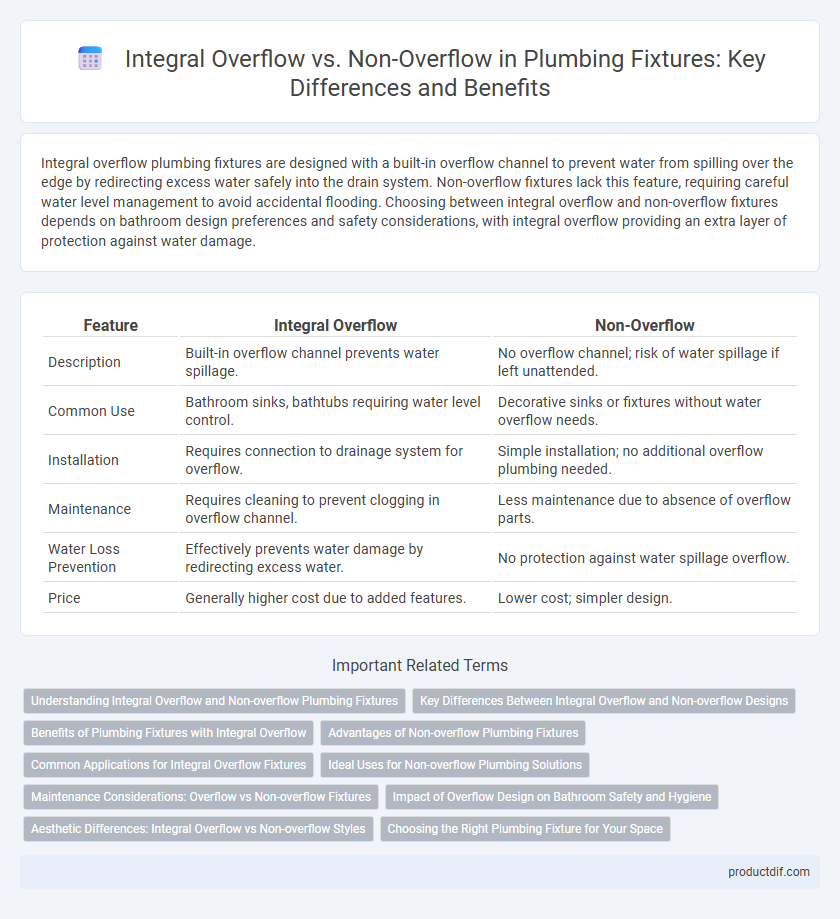Integral overflow plumbing fixtures are designed with a built-in overflow channel to prevent water from spilling over the edge by redirecting excess water safely into the drain system. Non-overflow fixtures lack this feature, requiring careful water level management to avoid accidental flooding. Choosing between integral overflow and non-overflow fixtures depends on bathroom design preferences and safety considerations, with integral overflow providing an extra layer of protection against water damage.
Table of Comparison
| Feature | Integral Overflow | Non-Overflow |
|---|---|---|
| Description | Built-in overflow channel prevents water spillage. | No overflow channel; risk of water spillage if left unattended. |
| Common Use | Bathroom sinks, bathtubs requiring water level control. | Decorative sinks or fixtures without water overflow needs. |
| Installation | Requires connection to drainage system for overflow. | Simple installation; no additional overflow plumbing needed. |
| Maintenance | Requires cleaning to prevent clogging in overflow channel. | Less maintenance due to absence of overflow parts. |
| Water Loss Prevention | Effectively prevents water damage by redirecting excess water. | No protection against water spillage overflow. |
| Price | Generally higher cost due to added features. | Lower cost; simpler design. |
Understanding Integral Overflow and Non-overflow Plumbing Fixtures
Integral overflow plumbing fixtures feature built-in overflow openings that prevent water from spilling over by redirecting excess water through the drainage system, enhancing safety and minimizing water damage risks. Non-overflow fixtures lack these built-in overflow pathways, requiring careful monitoring to avoid accidental flooding and often relying on external mechanisms to manage excess water. Understanding the differences between integral overflow and non-overflow fixtures is essential for selecting appropriate plumbing solutions tailored to specific safety, design, and functionality requirements.
Key Differences Between Integral Overflow and Non-overflow Designs
Integral overflow plumbing fixtures include a built-in overflow channel that prevents water from spilling over by redirecting excess water back into the drain, enhancing safety and preventing flood damage. Non-overflow fixtures lack this feature, relying solely on careful water level management to avoid overflow, which may increase the risk of spills in case of unattended filling. The choice between integral overflow and non-overflow designs affects installation complexity, maintenance requirements, and water damage prevention, making it crucial for specific plumbing applications and user needs.
Benefits of Plumbing Fixtures with Integral Overflow
Plumbing fixtures with integral overflow provide enhanced protection against accidental water spills by redirecting excess water safely into the drain, preventing flooding and water damage. These fixtures improve bathroom safety and reduce the risk of costly repairs by ensuring water levels remain controlled. Their design also supports efficient water management, contributing to overall plumbing system longevity and maintenance ease.
Advantages of Non-overflow Plumbing Fixtures
Non-overflow plumbing fixtures offer a streamlined design that reduces potential leak points and simplifies installation and maintenance. They allow for greater water containment control, minimizing the risk of accidental drainage or overflow issues. This design enhances durability and reliability, making non-overflow fixtures ideal for spaces where precise water management is crucial.
Common Applications for Integral Overflow Fixtures
Integral overflow plumbing fixtures are commonly installed in bathroom sinks and lavatories to prevent water spillage by allowing excess water to drain through built-in overflow channels. These fixtures are essential in residential and commercial bathrooms where accidental overflows could cause water damage. Integral overflow designs enhance safety by providing a secondary drainage path while maintaining an aesthetically seamless appearance.
Ideal Uses for Non-overflow Plumbing Solutions
Non-overflow plumbing fixtures are ideal for spaces where aesthetic simplicity and minimal maintenance are prioritized, such as powder rooms or guest bathrooms. These fixtures prevent water from escaping through the overflow, reducing potential clogs and simplifying cleaning routines. Their design is best suited for areas with low water usage and where overflow drainage is unnecessary.
Maintenance Considerations: Overflow vs Non-overflow Fixtures
Integral overflow plumbing fixtures simplify maintenance by preventing water from spilling over, reducing the risk of water damage and mold growth. Non-overflow fixtures require more frequent monitoring and cleaning to avoid blockages and potential overflow incidents. Choosing between integral overflow and non-overflow fixtures impacts long-term upkeep costs and safety management in residential and commercial plumbing systems.
Impact of Overflow Design on Bathroom Safety and Hygiene
Integral overflow plumbing fixtures incorporate built-in drainage channels that prevent water from spilling onto bathroom floors, reducing slip hazards and water damage. Non-overflow fixtures lack this safety feature, increasing the risk of overflows that can lead to mold growth and unsanitary conditions due to stagnant water. Opting for integral overflow designs enhances bathroom safety and hygiene by effectively managing excess water and maintaining cleaner environments.
Aesthetic Differences: Integral Overflow vs Non-overflow Styles
Integral overflow plumbing fixtures feature a visible overflow opening that adds a traditional, functional aesthetic, often blending well with classic or transitional bathroom designs. Non-overflow fixtures present a sleek and seamless appearance without an overflow hole, enhancing modern, minimalist bathroom styles with clean lines and uninterrupted surfaces. Choosing between integral overflow and non-overflow styles depends on balancing aesthetic preference with functional requirements in bathroom design.
Choosing the Right Plumbing Fixture for Your Space
Selecting the right plumbing fixture involves understanding the difference between integral overflow and non-overflow designs, as integral overflow fixtures prevent water from spilling by allowing excess water to drain through a built-in channel. Non-overflow fixtures, lacking this feature, require careful monitoring or external systems to avoid flooding. Opting for integral overflow fixtures enhances safety and convenience, especially in bathrooms or kitchens with limited supervision or higher usage.
Integral Overflow vs Non-overflow Infographic

 productdif.com
productdif.com